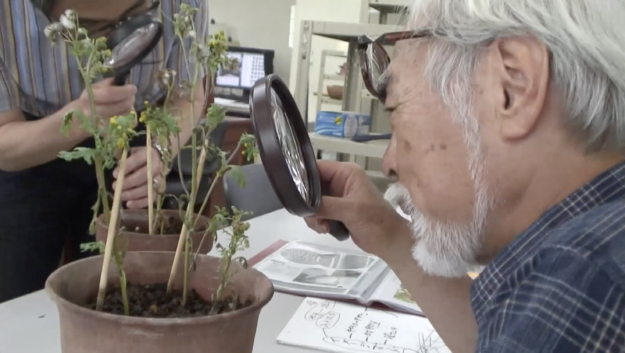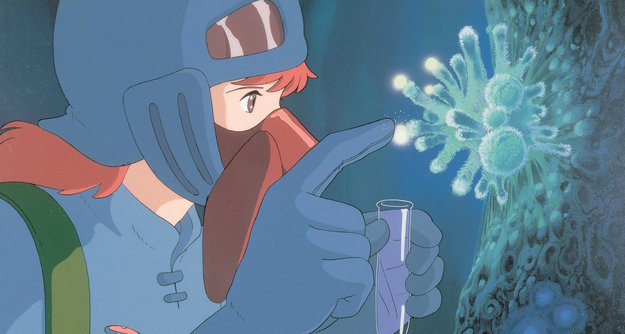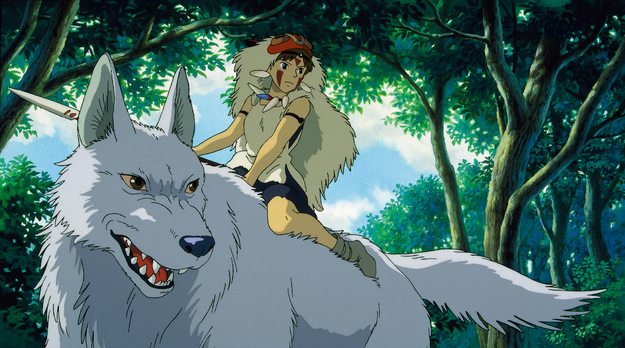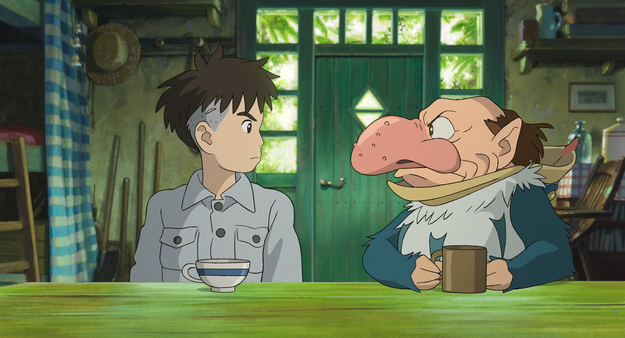Have you watched the Boy and the Heron yet? In Miyazaki latest film the boy Mahito, together with a supernatural Blue Heron, experiences the adventure of a lifetime. The screen is brimming with colourful characters, even the main star in our Japanese Knotweed season had a small role! Like other Miyazaki films, the Boy and the Heron blurs boundaries between good and bad, life and death and native and non-native. In this article I will discuss three films from Miyazaki and I argue that we can learn by looking through Miyazaki’s eyes. His vision helps us to relate to the world differently and imagine new futures.
The Ohmu and the Itadori
Nausicaä of the Valley of the Wind is about the possibility of life in the ruins that are left by humankind. It’s about a post-apocalyptic ‘contaminated’ world, partly covered by the ‘Toxic Jungle’. At the same time there is conflict between humans and the Ohmu. These sentient giant insect-like creatures swarm and are highly destructive when enraged by humans. But by showing empathy and respect towards them Nausicaä learns they are actually helping to purify the ‘Toxic Jungle’.
The story of the Ohmu is to me reminiscent of the Itadori (Japanese Knotweed), do they share their metaphorical meaning? Whilst both fear inducing (like a monster) and uncontrollable -or should I say rebellious- they thrive as a species, are able to live in human-disturbed ecologies and possibly even share some of the same goals as us. But they are not treated as such. The main lesson is really to consider the intelligence of non-humans and to respect their agency. What would happen if we would go even further and look at them as our teachers?
Nature and Culture
Princess Mononoke displays the entanglement between nature/culture and human/more-than-human. The film is about princess San -Mononoke- who, together with gods and spirits from Shishigami/Didarabotchi’s forest, is in conflict with Lady Eboshi from Iron Town. The mediator and main protagonist of the story is Ashitaka. His refusal to choose sides between Lady Eboshi and San agrees with the statement that the realm of culture cannot be separated from nature.
The interconnectedness between species and places is shown through narrative elements like the ‘curse’ contaminating across species, interspecies relationships, but also the character of San who is always ‘in between’ human and more-than-human. The messiness of these contact zones demonstrate the difficulty of demarcating nature and culture. The character of Shishigami/Didarabotchi, referred to as “life itself”, does not differentiate between species, demonstrating that environmental upheaval does not choose sides when it threatens all life forms. And what will result from War between species? What if we try to share our territory?
Miyazaki's final message?
Miyazaki is approaching the end of his career and entering the last stage of his life which shines through in his last film. The theme of life and death is very foregrounded. Towards the end, we learn that the parallel world of Mahito’s uncle is a failure, stacking the building blocks to re-balance the world is difficult and maybe even undesirable. This points to the dangers of world-building when longing for nostalgic imagined pasts where nature was untouched and humans and non-humans lived together in harmony, because that never existed. And that is perhaps also the final message Miyazaki wants to give to his (young) audience: we should move beyond ‘returning’, and start focusing on the messy contact zone that is our world. It is never too late, even if life is messy, even after failure, destruction, we have to try and work on a better world.
Looking through Miyazaki's eyes
What I admire about Miyazaki’s filmmaking is that he moves away from putting humans at the centre of his stories and gives all beings agency in his movies. Instead of a world where we differentiate between human and more-than-human we should see the world as a place where all species are deeply intertwined and entangled in each other. Itadori’s rebellious nature is not always welcomed in our money-driven society, by damaging infrastructure and therefore property, the plant costs a lot. What if we looked at this damage differently? What if we tell a different story? Instead of seeing money wasted we see a courageous fight to regain territory. We could learn from the Itadori and leave more room for soil and green in our cities, in our homes. And maybe we should not take plants just because they are pretty, and destroy them just because they cost us money, like things. Eradication of the plant is impossible, driving both people and the Itadori insane. But if people move beyond 'returning', and learn to live with the plant; respect it, harvest it, and use it for its medicinal properties, we might finally make a first move away from our violent histories.
written by: Mila Benjamins (2024)



